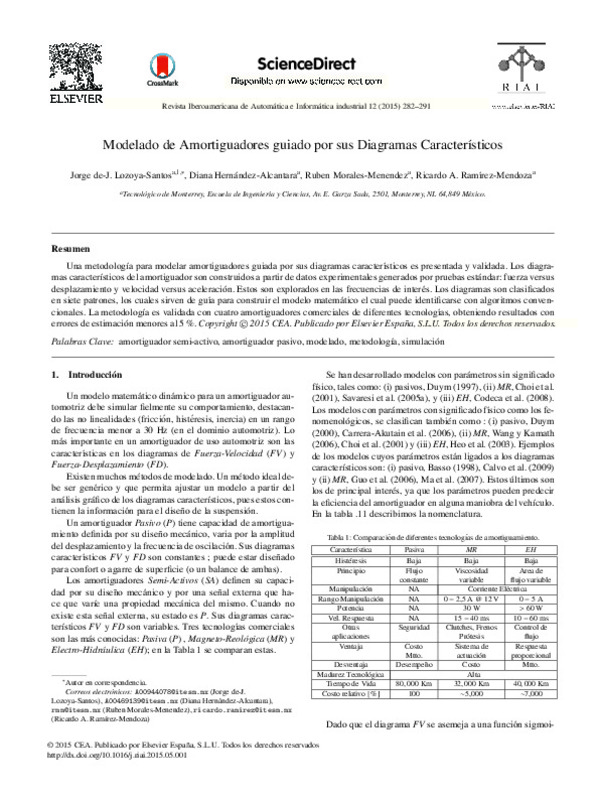BASSO, R. (1998). Experimental Characterization of Damping Force in Shock Absorbers with Constant Velocity Excitation. Vehicle System Dynamics, 30(6), 431-442. doi:10.1080/00423119808969459
Boggs, C.M., 2009. The Use of Simulation to Expedite Experimental Investigations of the Effect of High-Performance Shock Absorbers. Ph.D. thesis, Virginia Polytechnic Institute and State University.
Calvo, J. A., López-Boada, B., Román, J. L. S., & Gauchía, A. (2009). Influence of a shock absorber model on vehicle dynamic simulation. Proceedings of the Institution of Mechanical Engineers, Part D: Journal of Automobile Engineering, 223(2), 189-203. doi:10.1243/09544070jauto990
[+]
BASSO, R. (1998). Experimental Characterization of Damping Force in Shock Absorbers with Constant Velocity Excitation. Vehicle System Dynamics, 30(6), 431-442. doi:10.1080/00423119808969459
Boggs, C.M., 2009. The Use of Simulation to Expedite Experimental Investigations of the Effect of High-Performance Shock Absorbers. Ph.D. thesis, Virginia Polytechnic Institute and State University.
Calvo, J. A., López-Boada, B., Román, J. L. S., & Gauchía, A. (2009). Influence of a shock absorber model on vehicle dynamic simulation. Proceedings of the Institution of Mechanical Engineers, Part D: Journal of Automobile Engineering, 223(2), 189-203. doi:10.1243/09544070jauto990
Akutain, X. C., Vinolas, J., Savall, J., & Biera, J. (2006). A parametric damper model validated on a track. International Journal of Heavy Vehicle Systems, 13(3), 145. doi:10.1504/ijhvs.2006.010015
Çeşmeci, Ş., & Engin, T. (2010). Modeling and testing of a field-controllable magnetorheological fluid damper. International Journal of Mechanical Sciences, 52(8), 1036-1046. doi:10.1016/j.ijmecsci.2010.04.007
CHOI, S.-B., LEE, S.-K., & PARK, Y.-P. (2001). A HYSTERESIS MODEL FOR THE FIELD-DEPENDENT DAMPING FORCE OF A MAGNETORHEOLOGICAL DAMPER. Journal of Sound and Vibration, 245(2), 375-383. doi:10.1006/jsvi.2000.3539
Codeca, F., S.M. Savaresi, Spelta, C., Montiglio, M., Leluzzi, M., 2008. Identification of An Electro-Hydraulic Controllable Shock Absorber Using Black-Block Non-Linear Models. In: 17th IEEE Int Conf on Control Applications Part of IEEE Multi-conf on Syst and Control, USA. pp. 462-467.
Coleman, T. F., & Li, Y. (1996). An Interior Trust Region Approach for Nonlinear Minimization Subject to Bounds. SIAM Journal on Optimization, 6(2), 418-445. doi:10.1137/0806023
Duym, S., 1997. An Alternative Force State Map for Shock Absorbers. IMechE Proc Instn Mech Engrs Part D 211, 175-179.
Duym, S. W. R. (2000). Simulation Tools, Modelling and Identification, for an Automotive Shock Absorber in the Context of Vehicle Dynamics. Vehicle System Dynamics, 33(4), 261-285. doi:10.1076/0042-3114(200004)33:4;1-u;ft261
Heo, S.-J., Park, K., & Son, S.-H. (2003). Modelling of continuously variable damper for design of semi-active suspension systems. International Journal of Vehicle Design, 31(1), 41. doi:10.1504/ijvd.2003.002046
Joarder, M.N., 2003. Influence of Nonlinear Asymmetric Suspension Properties on the Ride Characteristics of Road Vehicle. Master's thesis, Concordia University, Canada.
Rakheja, S., & Sankar, S. (1985). Vibration and Shock Isolation Performance of a Semi-Active «On-Off» Damper. Journal of Vibration and Acoustics, 107(4), 398-403. doi:10.1115/1.3269279
Savaresi, S., Bittanti, S., Montiglio, M., 1 2005b. Identification of Semi-Physical and Black-Box Non-Linear Models: the Case of MR-Dampers for Vehicles Control. Automatica, 41 (1), 113-127.
Savaresi, S., Silani, E., Bittanti, S., Porciani, N., 2003. On Performance Evaluation Methods and Control Strategies for Semi-Active Suspension Systems. In: The 42nd IEEE Conf on Decision and Control. USA, pp. 2264-2269.
Savaresi, S., Spelta, C., July 2007. Mixed Sky-Hook and ADD: Approaching the Filtering Limits of a Semi-Active Suspension. J. Dyn. Sys., Meas., Control 129 (4), 382-392.
Sims, N. D., Holmes, N. J., & Stanway, R. (2003). A unified modelling and model updating procedure for electrorheological and magnetorheological vibration dampers. Smart Materials and Structures, 13(1), 100-121. doi:10.1088/0964-1726/13/1/012
Voronoi, G. (1908). Nouvelles applications des paramètres continus à la théorie des formes quadratiques. Premier mémoire. Sur quelques propriétés des formes quadratiques positives parfaites. Journal für die reine und angewandte Mathematik (Crelles Journal), 1908(133), 97-102. doi:10.1515/crll.1908.133.97
Wang, L. X., & Kamath, H. (2006). Modelling hysteretic behaviour in magnetorheological fluids and dampers using phase-transition theory. Smart Materials and Structures, 15(6), 1725-1733. doi:10.1088/0964-1726/15/6/027
Warner, B., 1996. An Analytical and Experimental Investigation of High Performance Suspension Dampers. Ph.D. thesis, Concordia University, Canada.
Wright, M.H., 1995. Direct Search Methods: Once Scorned, Now Respectable. In: Numerical Analysis 1995: Proceedings of the 1995 Dundee Biennial Conference in Numerical Analysis.
Yonaba, H., Anctil, F., & Fortin, V. (2010). Comparing Sigmoid Transfer Functions for Neural Network Multistep Ahead Streamflow Forecasting. Journal of Hydrologic Engineering, 15(4), 275-283. doi:10.1061/(asce)he.1943-5584.0000188
[-]








